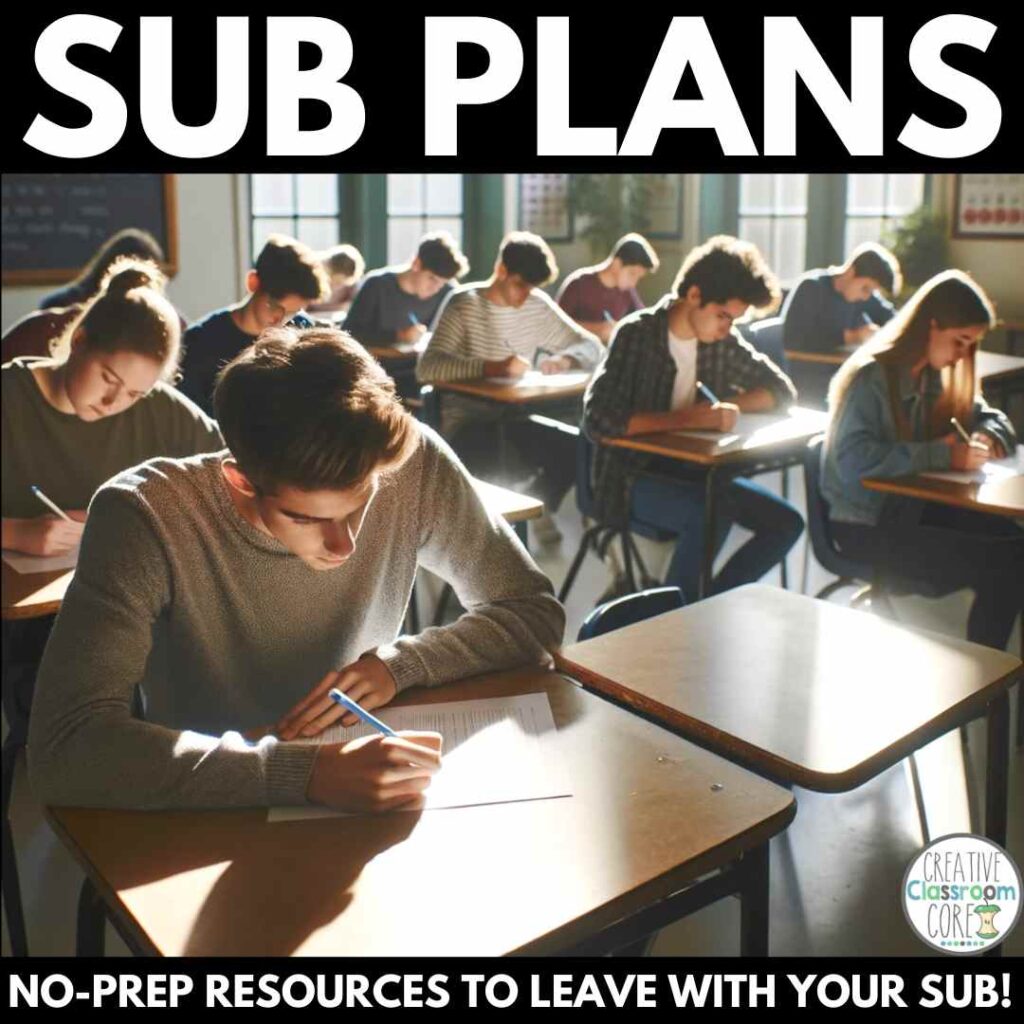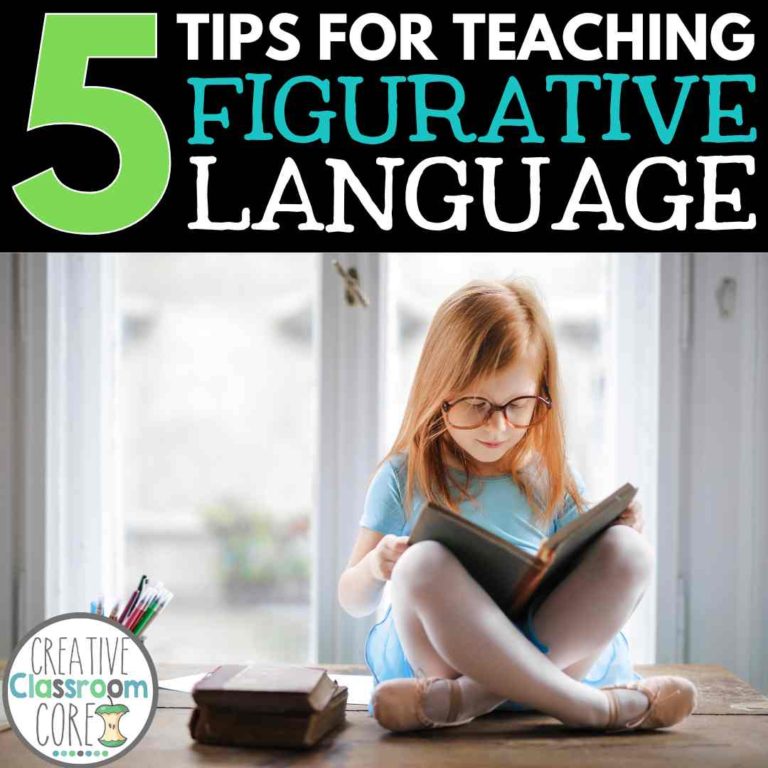Creating the Ultimate Sub Plan
By MARISSA DESPINS Updated April 09, 2024
What are Sub Plans?
Sub plans are an essential part of effective planning, ensuring that instruction continues smoothly even when the regular classroom teacher is absent. These well-prepared plans serve guide guest teachers in delivering the curriculum and maintaining order in the classroom. By recognizing the importance of sub plans, educators can minimize disruptions to student learning and ensure a seamless transition in the absence of the regular teacher.
In this post, we will explore the significance of sub plans and how they contribute to maintaining a productive and cohesive learning environment.

On the hunt for some no-prep sub plans that you can print and leave with your sub? Click on the button below to see all of the emergency sub plans available in my TPT shop!
Why are Sub Plans Important?
Students thrive on routine and structure, and any unexpected disruption can have a significant impact on their learning and behavior. Having emergency sub plans prepared and readily available ensures that a substitute teacher can step in seamlessly, providing a sense of consistency and normalcy for the students.
Maintaining consistency in instruction is crucial for effective teaching and learning. However, there are instances when a teacher is unable to be present in the classroom due to unforeseen circumstances. In such cases, having a well-thought-out substitute (sub) plan becomes essential. A sub-plan provides detailed instructions and resources for substitute teachers to ensure that instructional continuity is maintained in the teacher’s absence. By providing clear expectations, quality resources, and a structured framework, a sub plan not only supports substitute teachers but also helps students remain engaged and on track with their learning goals. It allows for seamless transitions, reduces disruptions, and enhances the overall learning experience.
Providing Guidance to Your Substitute Teacher
Substitute teachers play a crucial role in maintaining continuity in the classroom when the regular teacher is unable to be present. Sub plans are designed to provide clear instructions for the substitute teacher to follow. These plans outline essential details such as the daily schedule, classroom procedures, and specific instructions for each subject. By providing clear and explicit instructions, sub plans serve as a guide for substitute teachers to effectively manage the class and ensure that students remain engaged in their learning. This not only helps to minimize disruptions but also ensures that students continue to progress in their academic journey even in the absence of their regular teacher.
To ensure that emergency plans can be easily accessed and used by substitute teachers, they should be included in a dedicated sub binder or folder. This allows substitutes to quickly familiarize themselves with the class, the curriculum, and the expectations. The plans should consist of simple yet valuable lessons that can be taught at any point in the year, ensuring that students continue to learn and progress, regardless of when the absence takes place.
Creating the Ultimate Sub Plan
Substitute plans are an essential part of any teacher’s toolkit. Whether it’s due to illness, personal days, or professional development, teachers need to have a plan in place to ensure that their students continue to learn in their absence. Sub plans typically consist of various components, including a detailed schedule, instructional materials, and emergency procedures.

Overview And Objectives
This section of your sub plan gives you the opportunity to introduce yourself to the substitute teacher and your students. You should start this section with a brief explanation of your classroom and provide some context for the learning activities included in your sub plans. You should clearly articulate your learning objectives and specify what the students should know by the end of the class. By being forward with this information your sub has the best chance of successfully delivering your lesson.
Daily Schedule
Your sub plan should include an explanation of your daily schedule, which should include both administrative breaks as well as items unique to your classroom. Maintaining the timing and sequence of activities will help maintain the sense of routine that helps students adapt to changing teachers.
Start and End Times: Clearly state the start and end times of the school day, including when the substitute should arrive to prepare and when they can expect the day to conclude.
- Period Breakdown: List the times for each subject or class period, including the duration and any transitions between different rooms or activities.
- Breaks and Lunch: Specify the times for breaks, recess, and lunch, and any duties the substitute may have during these times, such as supervising students in the cafeteria or on the playground.
- Special Activities: Note any special activities that occur on that day, such as assemblies, field trips, special projects, or guest speakers, including the time and location for each event.
- Planning and Prep Time: Indicate any periods allocated for planning, preparation, or professional development, ensuring the substitute knows when these times are and how they can be used effectively.
- After-School Responsibilities: Outline any responsibilities after students are dismissed, such as meetings, student clubs, or sports coaching, if applicable to the substitute’s role.
 Provide Detailed Lesson Plans
Provide Detailed Lesson Plans
Creating lesson plans for a substitute teacher requires careful consideration of simplicity and the sub’s expertise. It is crucial to keep the plans easy to understand, as the substitute may have no prior knowledge about the class or its curriculum. By ensuring simplicity, the sub can easily follow the plans and effectively engage the students.
Materials and Resources
Ensure that you provide a comprehensive list of the materials and resources required for the lessons you wish to be taught. Remember, not everyone knows where to find the markers! This list should textbooks, workbooks, handouts, writing materials (like pens, pencils, markers, and chalk), and any technological devices or software that will be used, such as laptops, tablets, projectors, or specific educational apps and websites.
You should also discuss how the different materials should be used in the lesson to ensure your substitute can integrate them into your lesson plans correctly. Be sure to include any access information like passwords or login credentials should they be required. This thorough preparation allows the substitute to focus on teaching rather than gathering materials, facilitating a more effective and engaging learning experience for the students.

Emergency Procedures
Emergency procedures are an essential component of your sub plans. This section should include an outline of the various emergency procedures to be followed during different crisis situations. The procedures should cover fire drills, lockdowns, evacuations, tornado drills, and any other emergency and safety information that is relevant to the specific organization.
Fire drills should be a key component of the emergency procedures. They should outline the steps to be followed in the event of a fire, including the location of fire exits, the designated meeting point, and any specific actions to take to ensure the safety of all individuals.
Lockdown procedures are essential for situations where there is an immediate threat within the organization. These procedures should provide instructions on how to secure the premises, safeguard individuals, and communicate with law enforcement if necessary.
Evacuation procedures are vital for circumstances where leaving the premises is the safest option. They should include clear directions on how to safely evacuate the building, the assembly point, and any responsibilities assigned to designated evacuation coordinators to ensure everyone is accounted for.
Tornado drills should also be included, especially in regions prone to such severe weather conditions. These procedures should provide guidance on how to seek shelter and protect individuals from potential harm caused by tornadoes or other severe storms.
In short, this is your chance to prepare your substitute for the unthinkable. Make sure they are prepared.
Classroom Management Tips
Beyond preparing your substitute for your lessons, you should also arm them with the knowledge needed to succeed in interacting with your students. You should be sure to include the classroom rules and procedures, such as how students are expected to behave, rules for speaking or asking for help etc.
Given your experience, you may have also developed unique strategies that are effective with your students. Consider this and describe any positive reinforcement techniques, quiet signals, or even a points system if you have one. You can also explain how to deal with any common behavioral issues like off-task behavior, and roughhousing, and provide guidance on how to escalate serious problems to the administration.
Looking for more classroom management tips? Check out these 20 tips for new teachers!
Student Information
In this section, it is important to provide a detailed profile of the class to help the substitute teacher effectively manage and engage your students. You should include information in the total number of students or any seating plans you may have. Be sure to highlight any students with special educational needs or those in any additional learning assistance programs that may see them removed from the class. You may also provide a brief description of individual learning styles.
Additionally, you may provide some insights into the general feel of the class, like the overall behavior patterns, groupings that work well together, and any interpersonal issues that may affect classroom harmony. Inform the substitute of key student leaders or those who may need extra attention or support.
Assessment and Feedback
In this section of your sub plan, you should outline the different methods that the substitute teacher should use to evaluate student understanding and engagement throughout the lesson. This may be less critical for single-day subs, but should you be away for several days or more this type of information is very helpful in maintaining a sense of continuity for your students. This part of the plan may include
- Types of Assessment: Describe the various assessment methods to be used, such as quizzes, written assignments, class participation, or practical demonstrations. Specify any particular questions or tasks that should be given to gauge student understanding.
- Criteria for Success: Clearly define what constitutes successful completion of the lesson’s objectives. This might include the accuracy of answers, the level of participation, or the demonstration of specific skills and knowledge.
- Feedback Mechanisms: Provide guidance on how the substitute should give feedback to students. This could involve verbal feedback during class activities, written comments on assignments, or group discussions reflecting on the learning outcomes.
- Documentation and Reporting: Explain how the substitute should record student progress and any incidents or notable achievements during the lesson. Include where to find attendance sheets, grading rubrics, and how to communicate any concerns or observations to the regular teacher.
 Wrapping It Up
Wrapping It Up
Sub plans are crucial documents prepared by teachers to guide substitute teachers during their absence, ensuring that the instructional process continues seamlessly. These plans are vital for maintaining a consistent learning environment, especially for younger students who rely heavily on routine. Sub plans typically include detailed schedules, lesson instructions, materials needed, classroom management strategies, student information, assessment methods, and emergency procedures. By providing these comprehensive guidelines, sub plans help substitute teachers effectively manage the class, engage students in meaningful learning activities, and handle any situations that may arise, thereby minimizing disruptions and supporting ongoing educational progress.
Interested in reading more about preparing for a sub? Check out these 9 tips for substitute teachers!
Looking for some ready to go sub plans?
Are you on the hunt for some no-prep sub plans that you can print out and leave for your sub? Click on the image or button below to see all of the sub plans available in my TPT shop!
Interested in Signing up for my Email List?
If you are interested in signing up for my email list, you can do so by clicking on the link below. I periodically send out emails with free resources, teaching tips, and exclusive deals. Signing up will also give you immediate access to some of my best selling Interactive Notebook resources – foldable projects, graphic organizers, and other fun activities.
 Provide Detailed Lesson Plans
Provide Detailed Lesson Plans Wrapping It Up
Wrapping It Up 






